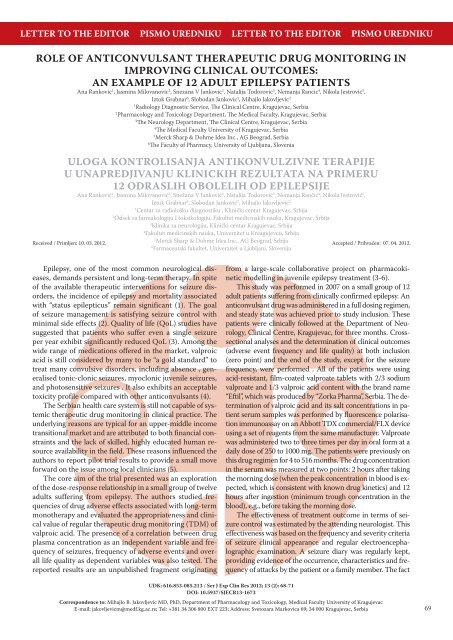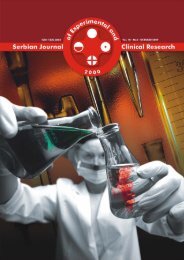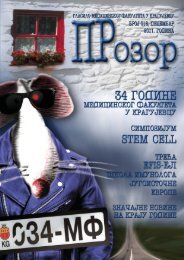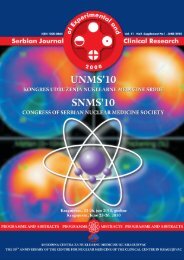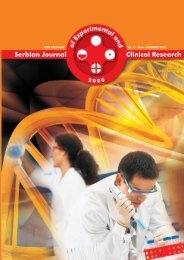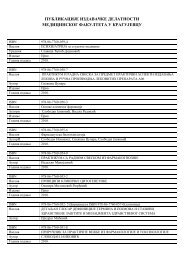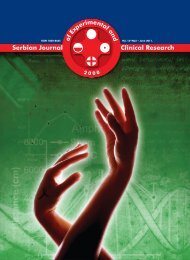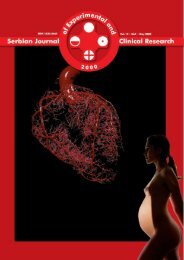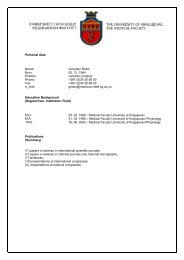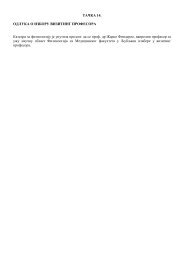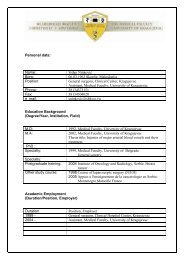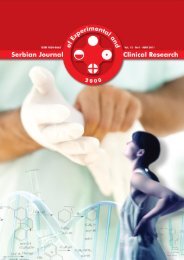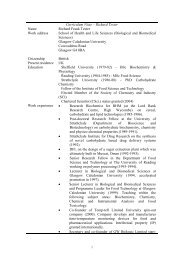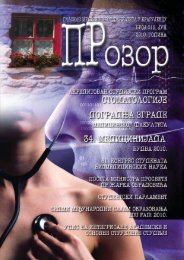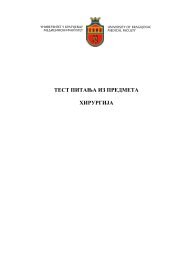Untitled - Medicinski fakultet Kragujevac - Univerzitet u Kragujevcu
Untitled - Medicinski fakultet Kragujevac - Univerzitet u Kragujevcu
Untitled - Medicinski fakultet Kragujevac - Univerzitet u Kragujevcu
Create successful ePaper yourself
Turn your PDF publications into a flip-book with our unique Google optimized e-Paper software.
LETTER TO THE EDITOR PISMO UREDNIKU LETTER TO THE EDITOR PISMO UREDNIKU<br />
ROLE OF ANTICONVULSANT THERAPEUTIC DRUG MONITORING IN<br />
IMPROVING CLINICAL OUTCOMES:<br />
AN EXAMPLE OF 12 ADULT EPILEPSY PATIENTS<br />
Ana Rankovic 1 , Jasmina Milovanovic 2 , Snezana V Jankovic 2 , Natalija Todorovic 3 , Nemanja Rancic 4 , Nikola Jestrovic 5 ,<br />
Iztok Grabnar 6 , Slobodan Jankovic 2 , Mihajlo Jakovljevic 2<br />
1 Radiology Diagnostic Service, Th e Clinical Centre, <strong>Kragujevac</strong>, Serbia<br />
2 Pharmacology and Toxicology Department, Th e Medical Faculty, <strong>Kragujevac</strong>, Serbia<br />
3 Th e Neurology Department, Th e Clinical Centre, <strong>Kragujevac</strong>, Serbia<br />
4 Th e Medical Faculty University of <strong>Kragujevac</strong>, Serbia<br />
5 Merck Sharp & Dohme Idea Inc., AG Beograd, Serbia<br />
6 Th e Faculty of Pharmacy, University of Ljubljana, Slovenia<br />
ULOGA KONTROLISANJA ANTIKONVULZIVNE TERAPIJE<br />
U UNAPREDJIVANJU KLINICKIH REZULTATA NA PRIMERU<br />
12 ODRASLIH OBOLELIH OD EPILEPSIJE<br />
Ana Ranković 1 , Jasmina Milovanović 2 , Snežana V Janković 2 , Natalija Todorović 3 , Nemanja Rančić 4 , Nikola Jestrović 5 ,<br />
Iztok Grabnar 6 , Slobodan Janković 2 , Mihajlo Jakovljević 2<br />
Received / Primljen: 10. 03. 2012.<br />
1Centar za radiološku dijagnostiku , Klinički centar <strong>Kragujevac</strong>, Srbija<br />
2Odsek za farmakologiju I toksikologiju, Fakultet medicinskih nauka, <strong>Kragujevac</strong>, Srbija<br />
3Klinika za neurologiju, Klinički centar <strong>Kragujevac</strong>, Srbija<br />
4Fakultet medicinskih nauka, <strong>Univerzitet</strong> u Kreagujevcu, Srbija<br />
5Merck Sharp & Dohme Idea Inc., AG Beograd, Srbija<br />
6Farmaceutski <strong>fakultet</strong>, <strong>Univerzitet</strong> u Ljubljani, Slovenija<br />
Accepted / Prihvaćen: 07. 04. 2012.<br />
Epilepsy, one of the most common neurological diseases,<br />
demands persistent and long-term therapy. In spite<br />
of the available therapeutic interventions for seizure disorders,<br />
the incidence of epilepsy and mortality associated<br />
with “status epilepticus” remain significant (1). The goal<br />
of seizure management is satisfying seizure control with<br />
minimal side effects (2). Quality of life (QoL) studies have<br />
suggested that patients who suffer even a single seizure<br />
per year exhibit significantly reduced QoL (3). Among the<br />
wide range of medications offered in the market, valproic<br />
acid is still considered by many to be “a gold standard” to<br />
treat many convulsive disorders, including absence , generalised<br />
tonic-clonic seizures, myoclonic juvenile seizures,<br />
and photosensitive seizures . It also exhibits an acceptable<br />
toxicity profile compared with other anticonvulsants (4).<br />
The Serbian health care system is still not capable of systemic<br />
therapeutic drug monitoring in clinical practice. The<br />
underlying reasons are typical for an upper-middle income<br />
transitional market and are attributed to both financial constraints<br />
and the lack of skilled, highly educated human resource<br />
availability in the field. These reasons influenced the<br />
authors to report pilot trial results to provide a small move<br />
forward on the issue among local clinicians (5).<br />
The core aim of the trial presented was an exploration<br />
of the dose-response relationship in a small group of twelve<br />
adults suffering from epilepsy. The authors studied frequencies<br />
of drug adverse effects associated with long-term<br />
monotherapy and evaluated the appropriateness and clinical<br />
value of regular therapeutic drug monitoring (TDM) of<br />
valproic acid. The presence of a correlation between drug<br />
plasma concentration as an independent variable and frequency<br />
of seizures, frequency of adverse events and overall<br />
life quality as dependent variables was also tested. The<br />
reported results are an unpublished fragment originating<br />
UDK: 616.853-085.213 / Ser J Exp Clin Res 2012; 13 (2): 68-71<br />
DOI: 10.5937/SJECR13-1673<br />
from a large-scale collaborative project on pharmacokinetic<br />
modelling in juvenile epilepsy treatment (3-6).<br />
This study was performed in 2007 on a small group of 12<br />
adult patients suffering from clinically confirmed epilepsy. An<br />
anticonvulsant drug was administered in a full dosing regimen,<br />
and steady state was achieved prior to study inclusion. These<br />
patients were clinically followed at the Department of Neurology,<br />
Clinical Centre, <strong>Kragujevac</strong>, for three months. Crosssectional<br />
analyses and the determination of clinical outcomes<br />
(adverse event frequency and life quality) at both inclusion<br />
(zero point) and the end of the study, except for the seizure<br />
frequency, were performed . All of the patients were using<br />
acid-resistant, film-coated valproate tablets with 2/3 sodium<br />
valproate and 1/3 valproic acid content with the brand name<br />
“Eftil”, which was produced by “Zorka Pharma”, Serbia. The determination<br />
of valproic acid and its salt concentrations in patient<br />
serum samples was performed by fluorescence polarisation<br />
immunoassay on an Abbott TDX commercial/FLX device<br />
using a set of reagents from the same manufacturer. Valproate<br />
was administered two to three times per day in oral form at a<br />
daily dose of 250 to 1000 mg. The patients were previously on<br />
this drug regimen for 4 to 516 months. The drug concentration<br />
in the serum was measured at two points: 2 hours after taking<br />
the morning dose (when the peak concentration in blood is expected,<br />
which is consistent with known drug kinetics) and 12<br />
hours after ingestion (minimum trough concentration in the<br />
blood), e.g., before taking the morning dose.<br />
The effectiveness of treatment outcome in terms of seizure<br />
control was estimated by the attending neurologist. This<br />
effectiveness was based on the frequency and severity criteria<br />
of seizure clinical appearance and regular electroencephalographic<br />
examination. A seizure diary was regularly kept,<br />
providing evidence of the occurrence, characteristics and frequency<br />
of attacks by the patient or a family member. The fact<br />
Correspondence to: Mihajlo B. Jakovljevic MD, PhD, Department of Pharmacology and Toxicology, Medical Faculty University of <strong>Kragujevac</strong><br />
E-mail: jakovljevicm@medf.kg.ac.rs; Tel: +381 34 306 800 EXT 223; Address: Svetozara Markovica 69; 34 000 <strong>Kragujevac</strong>, Serbia<br />
69


